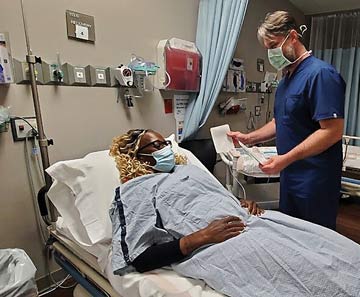Every surgical patient should be warmed, whether it's to keep them comfortable in chilly ORs or prevent the chilling effects of perioperative hypothermia. It's equally clear that warming amounts to good business, because keeping patients warm makes them as satisfied as much as it keeps them well. Our warming practices begin shortly after patients walk in the door and continue until moments before they leave. It's a big reason why poor outcomes and poor customer satisfaction surveys are nonexistent here. Here's how you can get the same results.
- In pre-op. Warming methods should begin shortly after patients arrive in pre-op. Discussing the benefits of your warming protocols as they slip on a thin surgical gown will ensure they're paying attention. Wrapping them in a warmed cotton blanket and slipping on warmed non-slip socks will make them even more receptive to hearing about the active warming methods you'll apply throughout their stay. Explain to patients that preventing perioperative hypothermia reduces risks for surgical site infections, cardiovascular complications, surgical blood loss and delayed wound healing.
Maintaining normothermia also decreases recovery times and ensures patients remain comfortable throughout their stay — some patients characterize shivering after surgery as worse than post-op pain.
- In the OR. When patients are wheeled to surgery, make sure a staff member is waiting for them in the hallway to apply a freshly warmed cotton blanket that will keep them comfortable as they enter the OR, which to many patients feels as cold as a meat locker. This is why we pivot to applying forced-air warming blankets once the patient is on the surgical table. We have 10 forced-air systems in our facility, which cost about $1,500 apiece. The blankets themselves come in packs of 10.
We use all of the active warming methods available to us — full-body blankets or under-body warming pads; gowns that cover only the upper or lower body; and gowns designed to cover the torso or chest — depending on the procedure being performed in order to maintain normothermia while providing surgeons with access to the surgical site. Conductive underbody thermal pads are also available to keep patients warm and maximize surgeons' access to surgical sites.
Once the patient is properly positioned on the table, treat the surgical site with a warmed prepping solution, if possible. We use a 2% chlorhexidine gluconate (CHG) and 70% isopropyl alcohol solution, which can be warmed to 86°F. (A couple of our surgeons also use povidone-iodine as a prepping solution, which we do not warm.) If you don't warm prepping solutions, consider storing them in pre-op or the PACU where it's slightly warmer than the OR.
Keep patients actively warmed for the duration of their time in the OR. Monitor their core temperature during all phases of the surgery. Maintain the OR's temperatures within the range recommended by national guidelines. (AORN recommends keeping the thermostat set between 68°F and 75°F.)
Warmed IV fluids can also help maintain normothermia in patients. Most fluids can be warmed in warming blanket cabinets set to 100°F. The warm fluids reduce vasoconstriction, and research has shown that warming IV and irrigation fluids keeps patients' core temperature half-a-degree warmer during surgery than room temperature fluids. We also warm the grounding pads used to protect patients during electrosurgery and the electrodes that attach to an external defibrillator in the event something goes wrong during procedures to implant pacemakers or cardioverter defibrillators. • In the PACU. Continue to monitor patients' temperatures and apply active warming methods until they register a normothermic temperature at least 15 minutes after arriving. Keeping patients warm makes for faster discharges. Shivering can cause cardiovascular stress from increases in oxygen consumption, carbon dioxide production and overall cardiac output that can lead to complications. In old, frail or other high-risk patients, these factors can contribute to complications such as myocardial infarction, ischemia or hypoxemia. I don't feel the need to explain all the clinical benefits of warming to most patients. It's usually enough to simply say that you want them to have a quick and comfortable recovery.
.svg?sfvrsn=be606e78_3)

.svg?sfvrsn=56b2f850_5)